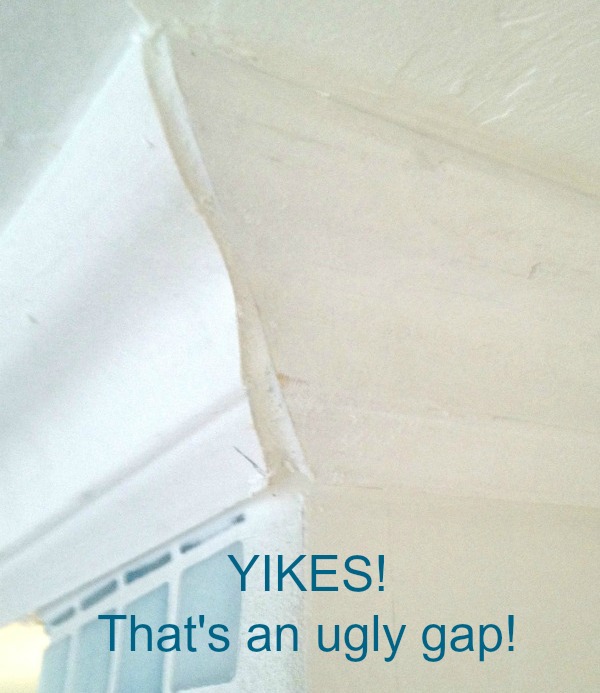Crown molding, the intricate and elegant trim that adorns the juncture of walls and ceilings, adds an undeniable touch of sophistication to any room. However, even the most meticulously installed crown molding can fall prey to unsightly gaps that detract from its aesthetic appeal. These gaps can arise due to various factors, such as settling, warping, or poor measurements. If you find yourself confronted with crown molding gaps, fret not, for this comprehensive guide will lead you through a step-by-step process, empowering you to restore the seamless perfection of your crown molding.

Image: sawdustgirl.com
Identifying and Assessing Crown Molding Gaps
The first step towards rectifying crown molding gaps lies in carefully identifying and assessing their location and severity. Examine the gaps with a discerning eye, noting their size, shape, and distribution. Are they concentrated in specific areas or evenly spaced throughout the length of the molding? Understanding the nature of the gaps will guide you in selecting the most appropriate repair techniques.
Rectifying Gaps with Caulk
Caulk, a malleable sealant, proves invaluable for filling small gaps in crown molding. Choose a caulk specifically formulated for molding or trim, ensuring a durable bond. Begin by cleaning the gap thoroughly, removing any dust, debris, or paint residue. Apply a thin bead of caulk along the length of the gap, taking care not to overfill it. Smooth the caulk using a damp finger or a caulk tool, ensuring it seamlessly blends with the surrounding molding. Allow the caulk to dry completely, typically within 24 hours. Once dry, you can paint or stain the caulk to match the existing molding.
Tackling Larger Gaps with Trim Filler
When faced with larger gaps, trim filler, a lightweight and paintable adhesive, offers an ideal solution. Trim filler is particularly advantageous for gaps that exceed the filling capacity of caulk. As with caulk, commence by meticulously cleaning the gap. Apply a generous bead of trim filler into the void, ensuring it completely fills the gap. With a damp putty knife or trowel, smooth the trim filler, ensuring it is level with the surrounding molding. Allow the trim filler to dry for the duration recommended by the manufacturer, ranging from several hours to a few days. Once dry, sand the area lightly to ensure a smooth, even finish. Finally, paint or stain the repaired area to blend it seamlessly with the existing molding.

Image: www.ehow.com
Fixing Gaps with Shims
Should the gaps between the crown molding and the wall or ceiling prove too wide for caulk or trim filler, shims come to the rescue. Shims, thin strips of wood or plastic, are inserted into the gap, effectively creating a firm base for the molding to rest upon. To use shims, measure the width of the gap and cut a shim to the appropriate size. Apply a small amount of wood glue to the shim and insert it into the gap, gently tapping it into place. Nail or staple the shim to the wall or ceiling, taking care not to damage the molding. With the shim securely in place, reattach the crown molding, ensuring a snug fit.
Mending Cracks and Gaps with Wood Filler
Sometimes, crown molding gaps are accompanied by cracks or damage to the molding itself. In such cases, wood filler provides an effective solution for restoring the molding’s integrity. Choose a wood filler that matches the species and color of your crown molding. Clean the damaged area thoroughly, removing any splinters or loose fragments. Apply a generous amount of wood filler to the crack or gap, using a putty knife or trowel to fill the void. Smooth the wood filler, making sure it blends seamlessly with the surrounding molding. Allow the wood filler to dry completely, typically within 24 hours. Once dry, sand the repaired area to create a smooth, even surface. Finish by painting or staining the repaired area to match the existing molding.
How To Fix Crown Molding Gaps
Conclusion
Crown molding gaps, while seemingly minor imperfections, can detract from the overall aesthetic appeal of your room. However, armed with the knowledge and techniques outlined in this comprehensive guide, you can confidently address these gaps, restoring your crown molding to its pristine glory. Remember, patience and precision are key to achieving seamless and professional-looking results. By following these steps, you can transform unsightly gaps into a thing of the past, enhancing the beauty and elegance of your home’s interior.










